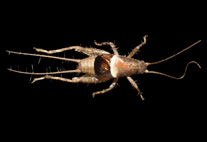Abstract
Three caddid harvestmen are known from eastern North America—Caddo agilis Banks, C. pepperella Shear and Acropsopilio boopis (Crosby) (Fig. 1). All also occur in Japan (Suzuki 1976; Shultz & Regier 2007), and all are apparently parthenogenetic, although a few male specimens of C. agilis are known (Gruber 1974, Suzuki & Tsurusaki 1983). The three species can be distinguished from other harvestmen by their large eye tubercle (ocularium), which occupies most of the carapace, as well as pedipalps with a proximal series of ventral spines. Acroposopilio boopis can be readily distinguished from the two Caddo species by its smaller size (body length < 1 mm in A. boopis versus 1.6–3.2 mm in Caddo) and the pedipalpal tarsus is shorter than the tibia rather than longer. (Fig. 1; Shear 1975). Caddo species can be difficult to separate as juveniles, but adult C. pepperella are smaller than C. agilis, (body length 1.6–1.9 mm in C. pepperella versus 2.8–3.2 mm in C. agilis) and the cuticle is brownish without prominent white or silver dorsal markings (Fig. 1; Shear 1975). In addition, the metapeltidium in C. pepperella bears a medial pair of fine erect projections that are absent in C. agilis (Shultz 1998).

